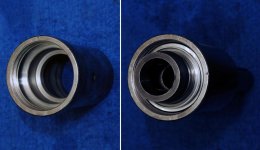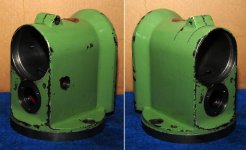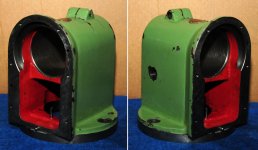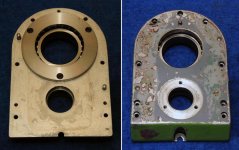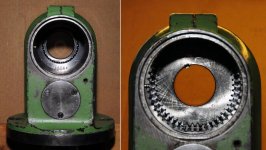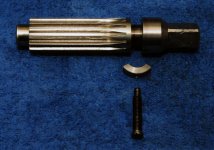kwijibo99
Plastic
- Joined
- May 4, 2010
- Location
- Melbourne, Australia
I was working on a milling project yesterday when the spindle bearings in the vertical head of my Thiel Duplex 158 began to consume themselves.
The lubrication on the Thiel vertical head is a total loss system so before running I usually give a few pumps of oil to the different lubrication points and a few drips come out through the bottom of the spindle every now and then during use. The first indication that something was not right was when it caught my attention that the oil drips were not the usual clean oil colour but much darker bordering on black, I gave them a quick wipe and made an alarming discovery:

The spindle did not sound noticeably noisier than usual when running at higher revs but spinning it by hand it did feel a little bit lumpy where it was usually perfectly smooth. I removed the head and began to strip it down for a closer look at what was going on. My concerns that the gears might be damaged were soon alleviated as they all looked perfect. The intermediate shaft bearings and as best I could tell the upper spindle bearing all appeared to run smoothly by hand and there were no metal chips anywhere to be seen, although there was grease which I'm pretty sure shouldn't be there.
I removed the quill which contains the lower spindle bearing and it definitely felt slightly lumpy when turning by hand so I suspect the lower spindle bearing is the source of the problem.
The issue I have now is that I have not been able to remove the lower spindle bearing retaining ring. I replaced the quill in the head and removed the small locking screw then made up a pin spanner which I hoped would do the job but the retaining ring is much tighter than I expected and I have not been able to budge it. The holes in the ring showed signs that it had been tinkered with before as there was a bit of distortion which I peened back to as close to original as possible before they got any worse.
Before and after peening the holes.


Looking at a drawing of the head it looks like this ring retains the lower bearing and also acts as a labyrinth seal.

Given that the top retaining ring was only firmly hand tight (and a right hand thread) I thought the lower ring would be similar but it stubbornly resists any attempt to remove it either clockwise or anti-clockwise.
I am guessing that the presence of a locking screw indicates Locktite or similar is not usually used in this situation.
Part of the problem is I don’t know if the thread is right or left handed and so have not wanted to apply a large amount of force in either direction. If anyone has worked on a Thiel or something similar and can offer any advice it would be most gratefully received.
Cheers,
Greg.
The lubrication on the Thiel vertical head is a total loss system so before running I usually give a few pumps of oil to the different lubrication points and a few drips come out through the bottom of the spindle every now and then during use. The first indication that something was not right was when it caught my attention that the oil drips were not the usual clean oil colour but much darker bordering on black, I gave them a quick wipe and made an alarming discovery:

The spindle did not sound noticeably noisier than usual when running at higher revs but spinning it by hand it did feel a little bit lumpy where it was usually perfectly smooth. I removed the head and began to strip it down for a closer look at what was going on. My concerns that the gears might be damaged were soon alleviated as they all looked perfect. The intermediate shaft bearings and as best I could tell the upper spindle bearing all appeared to run smoothly by hand and there were no metal chips anywhere to be seen, although there was grease which I'm pretty sure shouldn't be there.
I removed the quill which contains the lower spindle bearing and it definitely felt slightly lumpy when turning by hand so I suspect the lower spindle bearing is the source of the problem.
The issue I have now is that I have not been able to remove the lower spindle bearing retaining ring. I replaced the quill in the head and removed the small locking screw then made up a pin spanner which I hoped would do the job but the retaining ring is much tighter than I expected and I have not been able to budge it. The holes in the ring showed signs that it had been tinkered with before as there was a bit of distortion which I peened back to as close to original as possible before they got any worse.
Before and after peening the holes.


Looking at a drawing of the head it looks like this ring retains the lower bearing and also acts as a labyrinth seal.

Given that the top retaining ring was only firmly hand tight (and a right hand thread) I thought the lower ring would be similar but it stubbornly resists any attempt to remove it either clockwise or anti-clockwise.
I am guessing that the presence of a locking screw indicates Locktite or similar is not usually used in this situation.
Part of the problem is I don’t know if the thread is right or left handed and so have not wanted to apply a large amount of force in either direction. If anyone has worked on a Thiel or something similar and can offer any advice it would be most gratefully received.
Cheers,
Greg.






